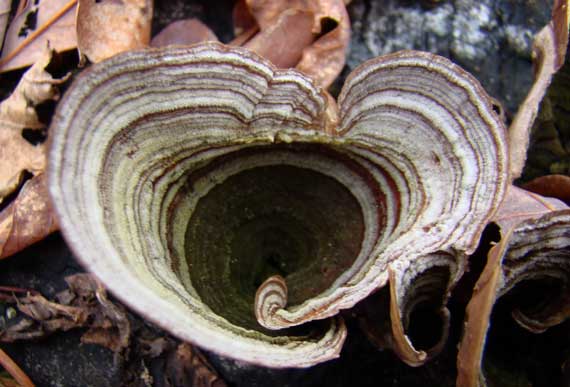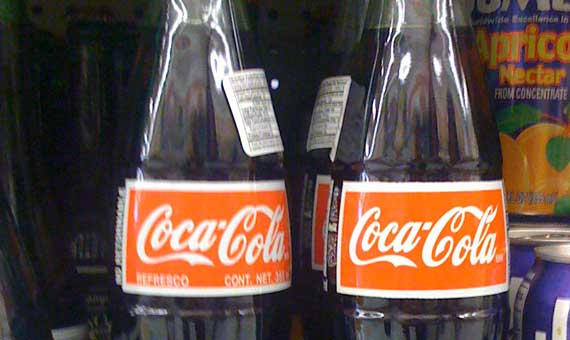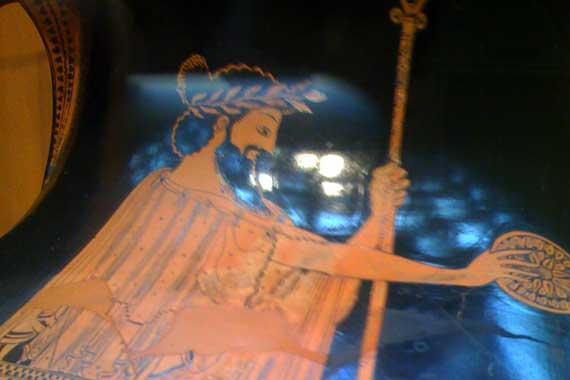Musings

Once again, I was reminded during Sunday’s hike that much as I enjoy examining fungi, lichen, and moss, I really know very little about them.
Yesterday’s hike in northwest Georgia should henceforth be known as the Rambutan Romp. The signature food (well, sorta) of the three intrepid participants was freeze-dried rambutan. John described the rambutan bits as resembling Amazon-box peanuts, although I think they have bit more flavor; for better or worse, they’re mostly carbs. We all were concerned, upon learning that the rambutans had been shelled and seeded by hand, that TJ’s is relying on child-labor to accomplish this (product of Thailand).
Also, I should confess this regarding yesterday’s outing: I fell in the creek during one of the maybe twenty crossings (remember, this was soon after a long rain). Brr. A bit bruised, but okay. Lots to laugh about, that!—and no pictures of that wet spring-sprawl, thankfully.
Posted at 11:23 AM |
Comments Off on Oh, and…

I can’t even guess what kind of phlox this is. BTW, phlox is a funny word, with its roots in the Greek word for flame. Appropriate, no? Yet, phlox varieties are native to North America and northeast Asia!
Today I heard lawn mowers for the first time, both to the south and to the east. Believe it or not!
Of course, the operators could have been conducting last-minute leaf-herding, instead of trimming spring-fresh grass….
In neighborhood news, Dish, once a favorite upscale restaurant of ours, is gone and defunct. A carpenter working on the redesign says the new restaurant going into the former gas-station location will be called Diesel. Still, I’m not warming to the idea of a restaurant named after a poison.
I’m not sure I’d feel that much better if it were named Biodiesel….
Posted at 5:18 PM |
1 Comment »
Recently I encountered this article abstract, Virtual water: Virtuous impact? The unsteady state of virtual water (2007), by Dik Roth and Jeroen Warner, and the phrase “virtual water” sure caught my eye. What they mean is water needed for crop production, with the implication that if you get your food from elsewhere, the water needed to grow (and ship) that food comes from that environment, not locally to you. I first encountered this concept, absent the catchy name, when a guide we had in Tanzania observed that flowers grown in Africa and shipped to the voracious flower markets in Europe meant Africa was effectively exporting water since flowers take so much to grow to the blooming stage. Anyway, having yesterday driven through flooding in Ohio and water sluicing in ditches in Kentucky, while thinking about the drought here in Georgia, water’s been on my mind.
To reduce the amount of virtual water you consume (or cause to be used), consider following Michael Pollan’s prescription: Eat food. Not too much. Mostly plants. (Pollan’s link, and a NYTimes article….)
Today’s vocabulary: iteroparous
Applies to organisms that reproduce more than once during their lifetimes. Examples include mammals, perennial plants. Iteroparous plants are more common in the tropics. In contrast, semelparous organisms reproduce only once in a lifetime. In general, semelparous species will produce more offspring from their single breeding event than iteroparous species. Iteroparity appears to be an adaptation to environmental (and thus reproductive) uncertainty.
I thought this a fine word (well, pair of words) for springtime….
Posted at 6:14 PM |
1 Comment »

I was going to blog about the lovely chicken with mustard sauce that Mouse made, but we ate it all up before I got a picture taken, and who wants to see an empty cook-pot?
And I could blog about all the laughing we did with KW and GG, but then I’d have to explain too much.
So, I’ll settle for a photo of the U-Scan that KW mentions so often in her blahg (or used to).
Posted at 10:22 PM |
2 Comments »

It’s the end of an era tonight; we said goodbye to our lovely houseguest. She left via Amtrak, cold-bound….
Science note
I’ve known to avoid good old MSG for years, but today I found out that there’re a whole raft of nasty sibling compounds lurking in our foods.
Since the 1970s, MSG has sidled back onto American supermarket shelves, under assumed names: hydrolyzed proteins, yeast extracts, protein concentrates and other additives that are not labeled as MSG but, according to nutritionists and the United States Department of Agriculture, are essentially the same thing: synthetically produced glutamates.
The whey protein concentrate and liquid aminos that many Americans buy at health food stores are also, essentially, pure glutamate…
According to USDA guidelines, “labeling is required when MSG is added as a direct ingredient.” But other glutamates—the hydrolyzed proteins, the autolyzed yeasts and the protein concentrates, which the USDA acknowledges are related to MSG—must be identified under their own names.
Alternatively, they may also be included under certain terms, like vegetable broth or chicken broth. Thus, these ingredients are now routinely found in products like canned tuna (vegetable broth is listed as an ingredient; it contains hydrolyzed soy protein), canned soup, low-fat yogurts and ice creams, chips and virtually everything ranch-flavored or cheese-flavored.*
Ick. Ick. And ick again.
* From Julia Moskin article in today’s NY Times.
Posted at 8:54 PM |
2 Comments »

The historic phrase, as I recall, mentions bread, wine, and thou. Tonight’s variation included Alon’s Carrot Cake, wine and other libations, and family….
Posted at 10:22 PM |
Comments Off on Party night!

Thanks JCB for the photo….
Several times we’ve enjoyed a sauteed green at Chinese restaurants. We don’t know what it’s called, and generally stumble around in a discussion with a well-meaning waitron, ending with happy nods all around, and a few minutes later we’re brought a steaming platter of these greens with a light oil and garlic sauce. Yum.
So, when I saw some pretty fresh fine looking raw ones displayed at Your DFM (dumb page; I refuse to link to it), I nabbed two bunches. The sign called them something like gailan broccoli in English and something else in something else.
I could feel a fine sand all over the leaves and stems, so carefully washed them—they’re draining here. Then I trimmed the bases and split the thick parts of the stems in quarters. I threw some garlic in the butter and then sauteed them. I think I used far less fat so they weren’t quite as tasty as the restaurant version, but, there ya go, that’s how it is the first time you cook something—and on your own, too!
Gross physiology suggests it’s in the Brassica family with broccoli and kolrabi, and sure enough, here it is, one of several forms of Brassica oleracea. Click on Gai Lan/Jie Lan for the best picture of what I’ve eaten, and you can buy seeds to boot!
I did all this googling for this blahg entry, and not, oddly, prior to my cooking adventure….
Posted at 5:07 PM |
1 Comment »

La Penserosa, 1856, by Hiram Powers, who apparently was the most widely known American sculptor in the mid-19th C. Newz to me! [At the High on Val-Day.]
How could I forget to mention that when out foraging the other day, at Star Provisions we saw among their lovely displays a chunk of imported Kobe beef for a mere $128 per pound. Plus sales tax. We left it languishing in the cooler.
Posted at 4:56 PM |
Comments Off on Pondering x2

These are approximately 12-ounce bottles….
You know this: the Co-Cola you get in the US is sweetened with (the nasty) HFCS*. Indeed, I think the whole New Coke maneuver was about switching US consumers to a dark liquid called Coke, but no longer tasting “right”, because it was no longer sweetened with sugar (aka sucrose)—the kind from cane or beets. When the dust had settled, the US market had been switched to a new cheaper Coke—that is, made with cheaper ingredients—yet sold at the same old price!
Suckers!
However. Even here in ATL (home of Coke), if you know the drill, you can get Coke made with sugar. Here’s how: go to a Latin market, or even the Latin section of the international aisle of your neighborhood Kro-gah (shown above), and, voila!, there it is, in a real glass bottle, with a paint job in Spanish, and a US nutrition sticker.
And the real twist (other than what this shipping does to the carbon footprint)? The price. $1.79. Plus tax.
* HFCS = high fructose corn syrup
Posted at 4:08 PM |
Comments Off on Inside story

Over at the High on Val’s Day I learned a new word— oinochoe, sometimes spelled oenochoe.
I knew krater (sometimes crater; Greek*: κεράννυμι)—those are the big vase-shaped vessels (sorta) with vertical sides and big open mouths (usually), with paintings on those straight sides (the art museum versions, anyway).
What I hadn’t retained was how kraters were used: they’re the Greek version of wine party-kegs. That’s where the wine was cut with some water, then the liquid was dipped out for the partiers. I guess kraters were probably important and central to the party scene, somewhat like a huge functional floral arrangement….
The oinochoe (Greek*: οινοχόη) was another part of the wine-party ritual and ceramic assemblage. It’s a smaller jug used to transport watered wine from the krater to the partiers. It has a curvier shape than the krater, and the examples I saw also had painted scenes on the shoulders and bulbous sides, and sometimes were decorated near the rims, too.
Anyway, the big take-home message here is that the Greeks (the haves, anyway) were big into the party scene complete with an assemblage of wine vessels, both decorative and functional. The partying was for more than simple pleasure (whoopee!). The various vessels also were placed in burials, so wine-feasts were linked not only to religious rituals but to funerary activities, too…. In a sense, this connection to wine undergirded the ancient Greeks’ sense of self and cultural identity, and they shipped wine to their colonies so they could continue to, well, be Greeks.
A corollary is that in the art museum setting, lovely archaeological artifacts lack their context (there I go again!), and are, for the most part, reduced to being just objects. Pretty, sometimes. Interesting, sometimes. But soulless. Spot-lit for aesthetics and little more….
* Greek translations are from Wikipedia….
Posted at 6:03 PM |
Comments Off on Krater vs Oinochoe









